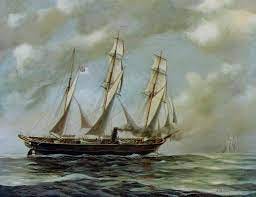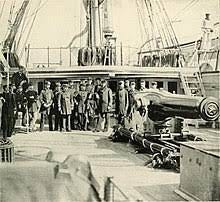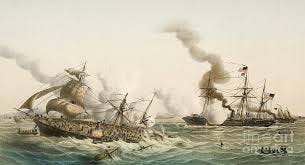Peril on the High Seas: Reading Off the Beaten Path
The epic hunt for the deadliest Civil War battleship
TO THE UTTERMOST ENDS OF THE EARTH: The Epic Hunt for the South's Most Feared Ship and the Greatest Sea Battle of the Civil War.
By Phil Keith with Tom Clavin
It’s a long title, but this is a whale of a tale. Special thanks goes to my dear mother-in-law who gifted me this book. She knows I have an eye for history. (She's 94 and nobody in the whole wide world reads more than she.)
ENDS OF THE EARTH is a gripping and entertaining book about the Confederate battleship, the CSS Alabama, and the fury it created during the Civil War. My initial revelation upon opening this book was to learn the extent of the Naval engagement between the Union and the South during the Civil War. The South was never known to have much of a formal Navy; and it was the Union that famously blockaded southern ports to diminish commerce and choke the life out of the Confederacy. But the South did have one ship: the CSS Alabama.
This is a story of a Confederate ship and its intrepid captain, the havoc they brought upon the Union, and the frantic response by the North. With the Union having effectively blockaded all major southern seaports, the South’s strategy was to combat Union supply and merchant vessels, to cut off the shipping of goods in and out of the North. But it needed warships so began building them overseas in Liverpool and France using fictitious names and phony partnerships, to evade British and French neutrality laws. Under such covert methods, the Alabama is built, crewed and launched in the UK.
The attacks begin and we witness the destructive power of the dreaded Alabama. It’s not uncommon for it to seize and burn two or three Union ships a day. Burning 20 or more indefensible merchant ships in a month was typical. Valuable commodities were seized. Quickly they ran out of room to put the spoils, so goods were scuttled, the crews locked up, and then (in most cases) the vessels were burned. Damage becomes rampant across the Atlantic.
Thus an international maritime saga of epic proportions across the high seas commences, and the chase is on to stop the Alabama. It’s an incredible game of cat and mouse, seamanship and naval strategy. The Alabama wreaks havoc across the eastern seaboard and Caribbean. After dozens of burnings and sinkings merchant traffic grows scarce in North America, so the Alabama moves across the Atlantic and attacks ships off the coast of Europe, Gibraltar, Africa, and as far away as Indonesia and Singapore. It’s the most feared warship on the seas and forces the Union to react and drastically change its war effort. The Union spreads out globally and spares no expense to track down and sink one single ship.
The ‘hero’ of the story is Captain Raphael Semmes of the Alabama. His adversary is John Winslow, Captain of the USS Kearsarge. It's Winslow and the Kearsarge who are assigned to track down the Alabama. Fascinating to read their brief biographies and learn that pre-war, Semmes and Winslow were shipmates and acquaintances who went their separate ways when war broke out, only to become bitter Naval adversaries. Winslow must find the Alabama which could be anywhere in the entire world; he must do it, of course, without satellites, modern navigation, radar, or much radio. How does Winslow locate his prey? It’s fascinating history that put me on the edge of my seat.
The biographies of Captains Semmes and Winslow are brief but just enough; how they became acquainted through their military training, how they rose in their respective ranks, and how they were fit and clever enough to be assigned to the finest two warships in America during the 1860s.
Confederate Captain Semmes is a colorful character. He’s fearless, aggressive, driven. Every time Semmes captures and burns a merchant vessel, he collects the precious chronometer from the captured ship’s captain. By the end of the war he’d assembled a considerable collection of these. We learn about stoking coal, stockpiling cannons and cannonballs, and how wooden ships try to protect themselves from these. We learn that ocean-going commerce in the 1860s was truly international; Union ship owners knew they were subject to attack so they avoided the Americas; Semmes literally traveled the globe to find prey. The 1850’s is an era when ships evolve from wooden-masted sailing ships to steam-driven side-wheelers. The pace of ocean-going transportation is increasing rapidly, when commerce back and forth from Europe to America was snowballing.
Finally, the book builds to a climactic show-down when the ships square off. Both captains know the battle is coming, and in fact, they look forward to it. Nobody runs. Two evenly matched ships maneuver off the coast of France. (They must go outside the 6-mile limit to accommodate French laws, but rumors spread and townsfolk expect the clash for days; the whole thing is clearly visible from the coast and cliffs; people spread blankets and open picnic baskets to watch the cannonballs fly.) The minute-by-minute description of the battle is fantastic.
You read TO THE UTTERMOST ENDS OF THE EARTH to learn about the naval side of the Civil War, how the Union and the South fought each other, located each other's commerce, destroyed each other's vessels. There’re interesting tidbits on shipbuilding, evading neutrality laws, trickery in raising the flag/colors of the wrong country, and ocean-going commerce in the 1850s. You read the book to learn how two accomplished military officers rose through the ranks together, went their separate ways, only to return to meet and fight. There’s a bit about how the military echelons worked, how politics wove into it, how presidents assigned the captaincy to a particular vessel. You get great insight into shipping traffic across the Atlantic, around Africa and Asia.
You read this to see how ships got bigger and faster and certainly more expensive, how one vessel with 25 cannons like the Alabama can blast another ship out of the water in minutes. You read this book to marvel how one Confederate raider could cause so much damage to the Union. You read this to learn about Confederate Captain Raphael Semmes; he's every bit as dynamic as Robert E Lee or Ulysses S Grant. What Semmes did for the South was inestimable. He was cavalier, a true free spirit, a one-of-a-kind individual in American history who more people should know about. Finally, you read this book for the epic climax: after a two-year international chase, the culmination is the greatest sea battle of the Civil War. This is a dramatic read which ties together many elements that fell together during the Civil War. You do NOT need to be a history fan to enjoy this, it's simply an enthralling story.
Here's the Amazon page for UTTERMOST ENDS of the EARTH
Thanks for reading. Please share with a friend.
Have any recommendations readers might be interested in? Let me know!
Michael Daswick






